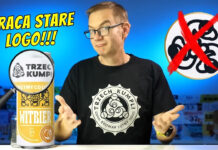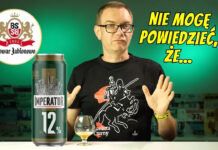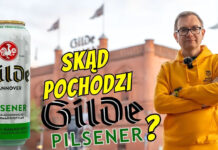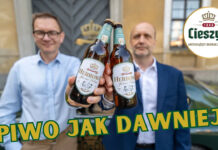Dzięki jednemu z widzów, a konkretnie dzięki Łukaszowi Stolarczykowi z Londynu, mogę Wam zaprezentować opis New England IPA, który być może z pewnymi zmianami pojawi się niedługo w przewodniku BJCP w kategorii Speciality IPA.
Zaktualizowana wersja opisu poniżej [31.03.17].
21B. Specialty IPA: New England IPA
Overall Impression: An American IPA with intense fruit flavors and aromas, a soft body and smooth mouthfeel, and often opaque with substantial haze. Less perceived bitterness than traditional IPAs but always massively hop forward. This emphasis on late hopping, especially dry hopping, with hops with tropical fruit qualities lends the specific ‘juicy’ character for which this style is known.
Aroma: Intense hop aroma, typically with fruity qualities (stone fruit, tropical fruit, and citrus are most commonly present) reflective of newer American and New World hop varieties without being grassy or herbaceous. Clean, neutral malt in the background, potentially with a light bready sweetness without caramel. Neutral to fruity fermentation character that is well-integrated with the hops. Any perceived alcohol character should be restrained and never hot.
Appearance: Color ranges from straw to yellow, sometimes with an orange hue. Hazy, often opaque, clarity; should not be cloudy or murky. The opacity can add a ‘shine’ to the beer and make the color seem darker. Medium to rocky meringue white head with high to very high retention.
Flavor: The hop flavor is high to very high, and reflects the same characteristics as the aroma (emphasis on fruit, with ripe tropical fruit, stone fruit, and citrus being most common). The perceived bitterness can be medium-low to medium-high, often somewhat masked by the body of the beer. Any hop character in the aftertaste should not be harsh. Low to medium-low malt flavor, generally neutral, sometimes with a bready, grainy, lightly sweet flavor. Noticeable caramel flavors are a flaw. Fermentation character is neutral to fruity, but as with the aroma, supportive of the hops. Off-dry to medium finish. Can have up to a moderate apparent sweetness from fruity esters, not unfermented sugars. Any perceived alcohol character should be restrained and never hot.
Mouthfeel: Medium to full body with a smooth, rich character. No harsh hop-derived astringency. Alcohol warmth may be present in stronger versions, but should never be hot. Medium carbonation is standard. A yogurt-like acidic twang is not appropriate.
Comments: The style is still evolving, but this style is essentially a smoother, hazier, juicier American IPA. In this context, ‘juicy’ refers to a mental impression of fruit juice or eating fresh, fully ripe fruit. Heavy examples suggestive of milkshakes or fruit smoothies are beyond this range; IPAs should always be drinkable. Haziness comes from the dry hopping regime, not suspended yeast, starch haze, set pectins, or other techniques; a hazy shine is desirable, not a cloudy, murky mess.
History: A modern craft beer style originating in the New England region of the United States. Alchemist Heady Topper is believed to be the original example and inspiration for many other interpretations that grew in popularity in the early to mid-2010s. Brewers are continuing to innovate and evolve the style.
Characteristic Ingredients: Similar to many newer American IPAs but often with more oats or wheat in the grist, and less caramel or specialty malts. Restricted hop choice to American or New World varieties with a tropical fruit, stone fruit, or citrus character. Neutral to estery yeast strain. Water ranges from balanced between sulfate and chloride to using more chlorides. Heavily dry-hopped, partly during active fermentation, using a variety of hopping doses and temperatures to emphasis hop depth of aroma and flavor over bitterness. Biotransformation of hop oils during fermentation adds to the fruit character.
Style Comparison: Compared to American IPA, New England IPA has a fuller, softer mouthfeel, a more fruit-forward late hop expression, a more restrained perceived bitterness balance, and a hazier appearance. Many modern American IPAs are fruity and somewhat hazy; if they have a dry, crisp finish, at most medium body, and high perceived bitterness, these examples should be entered as American IPAs.
Vital Statistics:
OG: 1.060 – 1.085
FG: 1.010 – 1.015
IBUs: 45 – 80
SRM: 3 – 9
ABV: 6.0 – 9.0%
Commercial Examples: Hill Farmstead Susan, Other Half Green Diamonds Double IPA, Tired Hands Alien Church, Tree House Julius, Trillium Congress Street, WeldWerks Juicy Bits












![Czym jest browar kontraktowy? [1 ze 100 pytań]](https://blog.kopyra.com//wp-content/uploads/2022/09/1ze100-pytań-czym-są-browary-kontraktowe-218x150.jpeg)


![P jak puszka piwa [Alfabet Piwa]](https://blog.kopyra.com//wp-content/uploads/2023/10/P-jak-puszka--218x150.jpeg)
![A jak alkohol w piwie [alfabet piwa]](https://blog.kopyra.com//wp-content/uploads/2023/02/a-jak-alkohol-218x150.jpeg)














![Szwajcaria Saksońska i Czeska [bez żadnego trybu]](https://blog.kopyra.com//wp-content/uploads/2023/05/szwajcaria-saksonska-i-czeska-218x150.jpeg)
![Grywalizacja aka gamifikacja [życie jest za krótkie]](https://blog.kopyra.com//wp-content/uploads/2023/03/grywalizacja-gamifikacja-218x150.jpeg)

![Ewangelię to trzeba najpierw głosić katolikom [Didymos]](https://blog.kopyra.com//wp-content/uploads/2024/10/ewangelia-katolikom-218x150.jpg)


Czyli można śmiało powiedzieć, że Doctor Brew warzyło NEIPA zanim stało się to modne 🙂
A tak jeszcze sobie myślę pod kątem piwowarstwa domowego, że jeśli dla West Coast IPA fermentacja burzliwa musiała być tak w optymalnie 18 stopniach aby nie było za dużo estrów, tak w tym stylu można fermentacje podkręcić, aby estry „wymieszały” się z aromatem chmielowym.
Jeszcze ostatnia dygresja: Vermont IPA od Pinty jest na S-04, a z tego co zauważyłem one mocno kłaczkują. Ciekawe, czemu użyli S-04, zamiast klasycznie US-05.
No bo S-04 dają pełniejsze, nieco słodsze i bardziej estrowe piwo niż US-05.
Trzeba przyznać trochę Frankenstein, ale nawet ma ręce i nogi.
Kopyr, zabrakło informacji jak należy chmielić pod NE IPA. A należy zacząć już od burzliwej, co lekko dodaje zmętnienie od chmielu i rzecz jasna podbija aromat i smak. Ponadto przy gotowaniu nie chmieli się na goryczkę, a najwcześniej zaczyna od chmielenia podwojonymi ilościami na ostatnie 15 min., czyli na smak/aromat, a przez podaną ilość i tak dodaje również lekką goryczkę.
To fundamenty chmielenia, jeśli chodzi o ten styl.
A czy NE IPA zlewamy w ogóle na cichą? Może lepiej było by potrzymać w jednym pojemniku?
Dzięki Tomek za wykład. Sporo rzeczy uporządkował. A czy są gdzieś podobne opisy dla West i East Coast IPA? Nie znalazłem ich w kategorii 21B.
Dobry film. Fajnie byloby, gdybys zrobil film o tym na jakich zasadach BJCP wprowadza nowe style. Z powyzszego filmu zrozumialem, ze opis sie spodobal jakiemus guru BJCP w USA i bedzie nowy styl. Mam nadzieje, ze te procesy sa bardziej transparentne.
No tak, ale jak się to wszystko ma do temperatury podawania piwa. W Stanach zawsze podają zmrożone, jak zauważyłem?
Zacząłem warzyć piwo bo trafił mnie amor co miał na drugie AIPA. Przestałem, bo większość moich APA, AIPA czy IIPA nie przypominało typowych dla stylu brandów a właśnie coś takiego. Dziś piłem sobie Vermont IPA z Pinty i Chinatown z Faktorii ( chociaż tu niby nie ma mowy o tym, że to NEIPA, ale skład, smak i aromat pasuje ) i stwierdzam, że tworzyłem coś takiego zanim stało się modne…i to wbrew sobie 🙂 Za mało chmielu na aromat, zalegająca goryczka, za dużo pływających drożdży, które aż czuć na żołądku… Ja raczej jestem mało krytyczny i dość łatwo się zachwycam, ale ten styl i wspomniane przykłady …. no mam jeszcze w piwnicy kilkanaście butelek podobnych, które jakoś nie weszły 🙁
synchronized wireless clocks
Purchase the top school pa systems that are available and in stock and reasonably priced get it now only!
Jak ma się do tego New England Absztifikanta – Jupikajej 5.0?